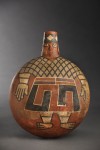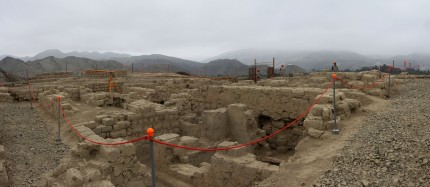 A team of Polish and Peruvian archaeologists have discovered a 1,200-year-old royal mausoleum from Peru’s Wari civilization which has never been looted. Wari tombs with precious grave goods have been found before, but this is the first untouched Wari tomb that bears the marks of royalty. The site surrounding the royal burial chamber in El Castillo de Huarmey, four hours north of Lima, was not so fortunate — it had been looted repeatedly over years — but the royal mausoleum was buried under 30 tons of stone fill which kept it safe from intruders.
A team of Polish and Peruvian archaeologists have discovered a 1,200-year-old royal mausoleum from Peru’s Wari civilization which has never been looted. Wari tombs with precious grave goods have been found before, but this is the first untouched Wari tomb that bears the marks of royalty. The site surrounding the royal burial chamber in El Castillo de Huarmey, four hours north of Lima, was not so fortunate — it had been looted repeatedly over years — but the royal mausoleum was buried under 30 tons of stone fill which kept it safe from intruders.
Maintaining that unbroken record was the first priority of the archaeological team. University of Warsaw archaeologist Milosz Giersz suspected there was a tomb on the spot when he saw the outline of it from in aerial photographs in June of 2010. Last September, the team found a room with a stone throne; underneath it was the thick stone fill. After doing what no looters had ever bothered to do, ie, dig deep into the fill, archaeologists found a large carved wooden mace and recognized it immediately as a tomb marker. They kept digging through the fill until they unearthed the mausoleum.
 The team found row after row of bodies wrapped in decaying traditional textiles made from llama wool and posed in a seated position. In three small adjacent chambers they discovered the human remains of three Wari queens buried with their valuables. When Giersz from the University of Warsaw saw the glint of gold in the tomb, he realized they would have to keep the discovery secret for the duration of the excavation or the place would be picked clean by human vultures.
The team found row after row of bodies wrapped in decaying traditional textiles made from llama wool and posed in a seated position. In three small adjacent chambers they discovered the human remains of three Wari queens buried with their valuables. When Giersz from the University of Warsaw saw the glint of gold in the tomb, he realized they would have to keep the discovery secret for the duration of the excavation or the place would be picked clean by human vultures.
Somehow they managed to keep the news from leaking for months as they unearthed more than a thousand artifacts. They found silver and gold jewelry, semi-precious stone beads, bronze ritual axes, silver bowls, knives, richly decorated ceramics, an alabaster drinking cup which is the only one of its kind ever found at an ancient Andean site,  carved wooden artifacts that survived in exceptional condition and my personal favorite, gold weaving tools kept in a cane box. Royal women couldn’t be expected to weave cloth with just regular tools, now could they? No, they wove with gold tools. I love that combination of practicality and luxury.
carved wooden artifacts that survived in exceptional condition and my personal favorite, gold weaving tools kept in a cane box. Royal women couldn’t be expected to weave cloth with just regular tools, now could they? No, they wove with gold tools. I love that combination of practicality and luxury.
A total of 63 bodies, most of them female, were buried in the mausoleum. The three with their own chambers were royalty, 54 of the others were probably high-ranking nobility. The six remaining were not buried seated or wrapped in textiles with expensive grave goods. They were deliberately placed on top of the other burials in curious poses. Archaeologists believe they were human sacrifices.
But for archaeologists, the greatest treasure will be the tomb’s wealth of new information on the Wari Empire. The construction of an imperial mausoleum at El Castillo shows that Wari lords conquered and politically controlled this part of the northern coast, and likely played a key role in the downfall of the northern Moche kingdom. Intriguingly, one vessel from the mausoleum depicts coastal warriors battling axe-wielding Wari invaders.
The Wari also waged a battle for the hearts and minds of their new vassals. In addition to military might, they fostered a cult of royal ancestor worship. The bodies of the entombed queens bore traces of insect pupae, revealing that attendants had taken them out of the funerary chamber and exposed them to the air. This strongly suggests that the Wari displayed the mummies of their queens on the throne of the ceremonial room, allowing the living to venerate the royal dead.
Analysis of this discovery has barely begun. Giersz expects his team to be studying the find for at least a decade.
The Wari civilization flourished in much of today’s Peru between 600 and 1100 A.D. Their territory covered almost the entire length of modern Peru and reached more than halfway inland. Their capital city Huari had a population of 40,000 at a time when Paris had a population of 25,000. Since few Wari remains have been found with their original context intact, we don’t know a great deal about the Wari. This tomb is therefore of immense importance to archaeologists as it will reveal much new information about Wari society.
For more pictures of the find, see this National Geographic photo gallery.
